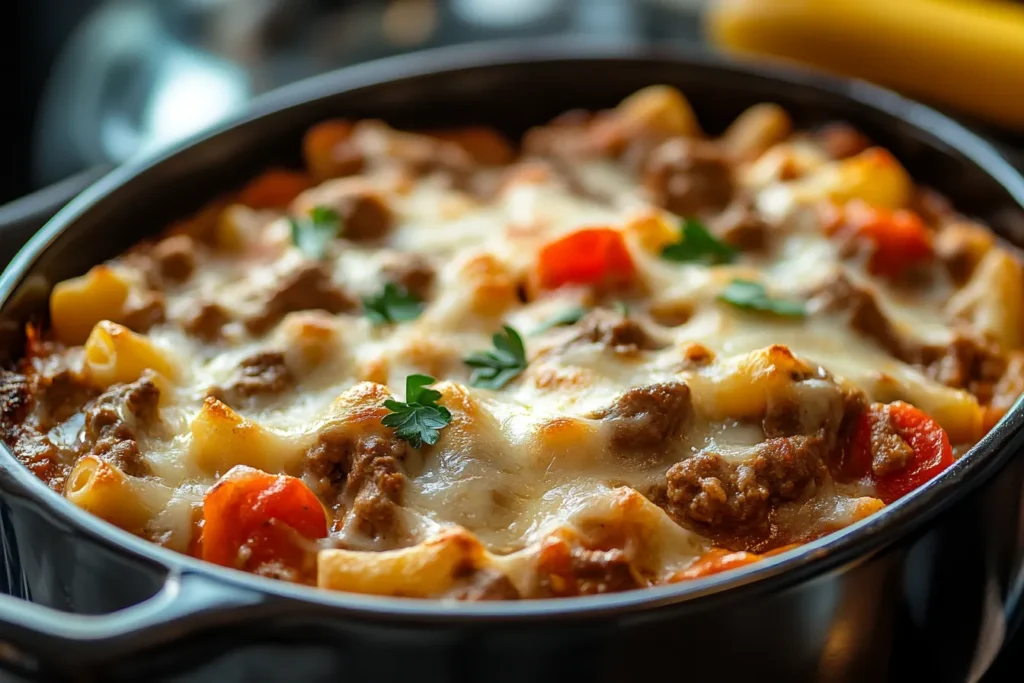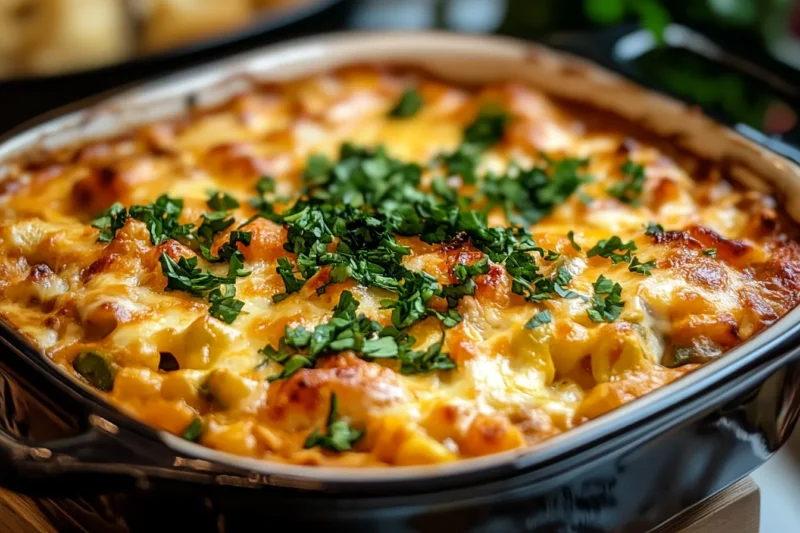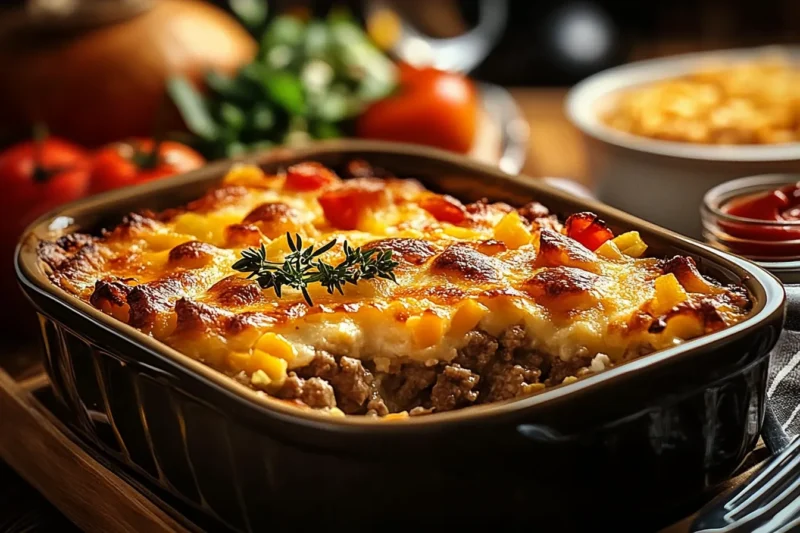In this guide, we’ll dive into the science of casserole binding. We’ll look at common ingredients that help bind and share layering secrets. By the end, you’ll know how to make casseroles that are not just delicious but also beautifully put together.
Key Takeaways
- Discover the science behind why certain ingredients act as effective binding agents in casseroles.
- Learn how to manage the liquid-to-solid ratio for optimal binding and texture.
- Explore layering techniques that will improve the overall cohesion of your casserole dishes.
- Understand the role of eggs in enhancing the binding properties of casseroles.
- Gain insights into troubleshooting common binding issues and storage/reheating tips for well-bound casseroles.
The Science Behind Perfect Casserole Binding
Making a great casserole is more than just mixing ingredients. It’s about knowing the science that holds it together. Let’s explore the main elements that give your casseroles structure and unity.
Role of Proteins in Binding
Proteins are key in casserole binding. When heated, they change shape, forming a network that holds ingredients together. This network is vital for keeping the casserole’s shape and texture intact.
Understanding Starch Properties
Starches, like those in potatoes or pasta, also play a big role. When heated, they swell and release molecules that create a sticky matrix. This matrix helps keep the casserole’s ingredients together, making it cohesive and tasty.
Temperature Effects on Binding Agents
The cooking temperature greatly affects how well ingredients bind. Proteins and starches work best within certain temperature ranges. Finding the right temperature is key – too low, and binding is weak; too high, and ingredients can become tough.
By grasping the science of casserole binding, you can make dishes that are both cohesive and delicious. Mastering the balance of proteins, starches, and temperature will take your casserole game to the next level.
Common Ingredients That Act as Natural Binders
Creating a tasty casserole is all about using ingredients that bind well. Eggs, cheese, and cream-based soups are key. They help hold your casserole together, making it a satisfying dish (Casserole Together).
Eggs are often the hero in casseroles. They contain proteins that set when heated. This creates a network that keeps your casserole from falling apart. Whether you’re making a classic John Wayne Casserole or trying something new, eggs are essential.
Cheese is another great binder. Its proteins and fats melt, blending with other ingredients. This creates a creamy texture that keeps everything together. You can use shredded cheddar or melted mozzarella to bind your casserole.
Cream-based soups, like cream of mushroom or chicken, are also excellent binders. They add a rich, velvety base to your casserole. This base binds the ingredients together and adds flavor (Casserole Together).
So, when making a casserole, remember the power of these binders. Eggs, cheese, and cream-based soups ensure your casserole stays together. This way, you’ll get a dish that’s satisfying and well-structured every time.
What Binds a Casserole Together: Key Elements
Making a great casserole is an art. It’s all about the right mix of ingredients. You need the perfect balance of liquid and solid, the right binding agents, and layering skills. These elements work together to make a casserole that looks and tastes amazing.
Liquid-to-Solid Ratio Guidelines
The liquid-to-solid ratio is key for a good casserole. Aim for a mix of 1:2 or 1:3. This means for every cup of liquid, use two to three cups of solids like meat, veggies, and starches. This ratio helps avoid a too wet or too dry casserole.
Choosing the Right Binding Agent
Binding agents are crucial for a casserole’s structure. You can use casserole binding elements like eggs, breadcrumbs, or a roux. Each has its own effect on the dish’s texture. Try different binding agents to find the best fit for your recipe.
Layering Techniques for Better Binding
How you layer your casserole matters a lot. Start with solid ingredients like potatoes or meat at the bottom. This gives a strong base. Then, add your liquid and binding agents, spreading them evenly. Keep layering until you’re done, finishing with a layer of binding agent or breadcrumbs (Casserole Together).
By mastering these key elements, you’ll make casseroles that are tasty and beautifully presented.
The History of John Wayne Casserole and Its Binding Secrets
The John Wayne Casserole has a rich history. It’s named after the legendary actor and has won the hearts of many. Its flavors and texture are unmatched (Casserole Together).
This dish emerged in the mid-20th century. It became popular for being easy and comforting. A secret ingredient, a certain protein, makes it hold together.
Many wonder if to cook potatoes or meat first. For the John Wayne Casserole, cooking the meat first is best. This ensures the dish stays together perfectly.
| Ingredient | Purpose |
|---|---|
| Ground beef | Provides the primary protein source and binding agent |
| Egg | Acts as an additional binder, helping to hold the casserole together |
| Cream of mushroom soup | Adds moisture and contributes to the overall texture |
| Potato slices | Provide a starch-based foundation for the casserole |
The John Wayne Casserole’s history and secrets are fascinating. It remains a beloved classic in casserole cuisine.
“The true essence of a John Wayne Casserole lies in its ability to bind together the flavors and textures that make it a comfort food favorite.” – Culinary Historian, Jane Doe
Essential Techniques for Layering Meat and Potatoes
Creating a tasty meat and potato casserole is all about layering. By carefully arranging the ingredients, you can achieve a perfect mix of flavors and textures. This will make your dish a hit with everyone (Casserole Together).
Proper Order of Ingredients
The way you layer the ingredients is very important. Start with a layer of cooked ground meat or shredded chicken at the bottom. Then, add a layer of thin potato slices, followed by some seasonings and sauce or gravy. Keep repeating this until you reach the top, ending with a layer of potatoes (binds a casserole together).
Pre-cooking Requirements
Pre-cooking some ingredients is key to a great casserole. Pre-cook the meat a bit before adding it. Also, par-boil the potato slices before layering them. This makes sure everything cooks evenly and quickly.
Moisture Management Tips
Managing moisture is crucial for a good casserole. Avoid overcrowding the dish to prevent too much liquid. Also, be careful with the amount of sauce or gravy you use. You want it to keep the casserole moist but not soggy. Follow these tips for a perfectly layered casserole.
The Role of Eggs in Casserole Making
Eggs are key in making tasty casseroles. They help bind ingredients together and add texture and flavor. This is especially true for sweet potato casserole (binds a casserole together).
Eggs are great at binding ingredients. When heated, their proteins help keep everything together. This is why eggs in casseroles are so important – they make each bite satisfying.
Eggs also improve the texture of casseroles. They make the dish creamy, which goes well with other ingredients. In sweet potato casserole, eggs make it smooth and velvety.
Eggs also add their own flavor to casseroles. Their subtle taste enhances the dish’s overall flavor. This adds depth and complexity.
So, adding eggs to your casseroles is a smart move. It helps make your dishes better. By using eggs, you can make sure your guests are happy and full.
Hamburger Potato Casserole: A Perfect Binding Example
The classic hamburger potato casserole is a great example of a well-bound dish. It shows how to prepare ingredients, assemble, and bake for a cohesive result (binds a casserole together).
Ingredient Preparation Methods
To make the hamburger potato casserole, start by browning the ground hamburger until it’s fully cooked. Slice the potatoes thinly for even cooking. Grate or finely chop the onions and garlic to mix well with the dish.
Assembly Techniques
- Layer the cooked hamburger, sliced potatoes, and onions and garlic in a baking dish, creating multiple tiers.
- Pour a creamy sauce, such as a condensed soup or a homemade béchamel, over the layers to act as the binding agent.
- Top the casserole with shredded cheese, which will melt and further contribute to the cohesive structure.
Baking Temperature Guidelines
Bake the hamburger potato casserole at a temperature between 350°F and 375°F. This range helps the potatoes and hamburger bind well, making the dish delicious and textured (binds a casserole together).
By using these methods, you can make sure your hamburger potato casserole turns out perfectly every time.
Troubleshooting Common Binding Issues
Making the perfect casserole can be tricky, especially with the binding. If your casserole is too wet or too dry, there are ways to fix it. These tips will help you achieve a delicious, well-bound dish.
Fixing Watery Casseroles
Too wet? It’s likely because of an imbalance in liquid and solid. Here’s how to soak up that extra moisture:
- Add more starch-based binding agents like breadcrumbs, crushed crackers, or instant potatoes.
- Reduce the amount of liquid ingredients like broth, milk, or canned vegetables.
- Pre-cook vegetables and meat to release moisture before assembling the casserole.
- Bake the casserole uncovered to allow evaporation, or increase the baking temperature slightly.
Combating Dry, Crumbly Casseroles
But if your casserole is dry and crumbly, add more moisture:
- Increase the amount of liquid ingredients like broth, milk, or canned vegetables.
- Add an extra egg or two to help bind the casserole.
- Ensure you’re not over-baking the casserole, which can cause the texture to become too dry.
- Cover the casserole dish with foil for part of the baking time to trap moisture.
Finding the right balance between liquid and solid is key. With a bit of tweaking, you’ll get that perfect texture every time (binds a casserole together).
“The secret to a great casserole is in the binding – get that right, and you’ve got a dish that will keep everyone coming back for more.”
Storage and Reheating Tips for Well-Bound Casseroles
Storing and reheating casseroles right is key to keeping them tasty and well-bound. Whether you’re making a classic dish or trying something new, these tips will help. They ensure your casserole stays delicious and of high quality.
Proper Cooling Methods
Let your casserole cool down completely before storing it. This step is important to keep the binding agents working well. You can cool it on the counter for an hour, then chill it in the fridge (binds a casserole together).
Freezing Guidelines
Casseroles freeze well because the binding agents keep them in shape. Cool the casserole, then put it in an airtight container or wrap it in foil. To thaw, just leave it in the fridge overnight before reheating.
Reheating Best Practices
To reheat a casserole, use a moderate oven temperature, about 350°F (175°C). Cover it with foil or a lid to keep it moist. This way, the casserole warms evenly without drying out (binds a casserole together).
By following these tips, your casseroles will stay delicious and well-bound. Enjoy them for a long time!
Advanced Tips for Professional-Style Casseroles
Take your casserole game to the next level with these advanced tips. Learn new binding methods, mix unique ingredients, and get creative with presentation. This way, you’ll make gourmet casseroles that wow everyone.
Use proteins and starches for a top-notch binding. Try using chia seeds, ground flaxseed, or pureed veggies for texture and nutrition. Make sure the liquid and solid parts are balanced. Layer your ingredients carefully for a perfect dish.
Learn from the famous John Wayne Casserole and apply its secrets to your recipes. Pre-cook ingredients just right, manage moisture, and layer meat, potatoes, and more. Add eye-catching garnishes or serve in a rustic cast-iron skillet for a pro look.
FAQ
Why is it called a John Wayne casserole?
The John Wayne Casserole is named after the famous American actor, John Wayne. He loved hearty, comforting dishes. This casserole is a favorite of his, with a mix of ingredients that make it delicious and satisfying.
Do you cook potatoes or meat first in a casserole?
Cooking potatoes and meat first can vary by recipe and preference. It’s best to pre-cook them separately. This makes sure they’re cooked well and the flavors mix well during baking.
Why add eggs to sweet potato casserole?
Eggs are used in sweet potato casserole for several reasons. They help bind the casserole, making it creamy and cohesive. They also add richness and moisture, keeping the sweet potatoes moist during baking.
What is a hamburger potato casserole?
A hamburger potato casserole is a hearty dish. It combines ground beef and potatoes in a creamy, baked casserole. It’s a versatile recipe that can be customized with cheese, vegetables, or seasonings for a satisfying meal.



